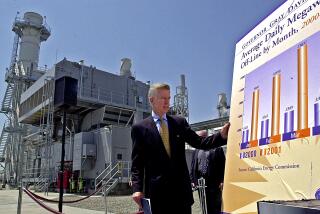Democrats Putting Davis at Risk
- Share via
SACRAMENTO — By the time the snow flies in the Sierra this fall, California will have a Republican governor -- if the Democrats have anything to do with it. That’s the only reasonable conclusion to draw after all prominent California Democrats took themselves out of the running to replace Gov. Gray Davis should the recall against him qualify for a fall vote, which seems probable.
We can predict who’s likely to vote if the recall election is held this fall and, based on past recalls, how they are likely to vote. It’s not good news for Davis.
In November 1993, 5.3 million Californians went to the polls in a special off-year election on a school voucher initiative. That number amounted to about one-third of California’s registered voters; 5.3 million voters also cast ballots in the 2002 primary.
These are California’s “regular voters”: Call an election and they turn out. They tend to be older, white, homeowners and more conservative than the electorate as a whole. In 2002, 44% of primary voters were registered Republicans. Davis received only 33% of the total ballots cast, and one in five Democratic primary voters went against him.
If 5.3 million turned out to vote on a voucher issue in 1993, we can expect at least that many to vote on a governor’s recall 10 years later. Furthermore, regular voters primarily rejected the voucher initiative, which lost by a margin of greater than 2-1, because of concern over its fiscal consequences. And if the fiscally minded is everyone who turns out to vote in a recall election, Davis cannot survive. He needs loyal Democratic voters.
In the 2002 general election, 7.7 million voters went to the polls. The 2.4 million “extra voters” exhibited the Democratic bias Davis needs to defeat the recall. Democrats had a 5% edge in the total electorate, and Davis beat his GOP opponent, Bill Simon, by 5%, although he received only 47% of all votes cast.
But the Democratic Party’s decision to run no replacement option in a recall election means it will be harder to motivate this additional Democratic turnout. It’s gambling that the recall will be a repeat of 2002, with only Rep. Darrell Issa or Simon as candidates. Simon and Issa are more conservative than the California electorate, so in a one-on-one election against either, Davis might survive.
There’s a problem: The recall process is not static. It’s not a one-on-one election. Anyone can run as a replacement for Davis, and the candidacy of either actor Arnold Schwarzenegger or former Los Angeles Mayor Richard Riordan would shatter the Democratic strategy.
We know Schwarzenegger cares about after-school programs. Riordan is pro-choice and liberal on a number of social issues. Neither is conservative enough to ensure Democratic loyalty to Davis. Schwarzenegger, in particular, could have Jesse Ventura-style appeal to younger voters and independents, thereby drawing a different set of voters to the polls who would vote to recall Davis.
By not assuring a replacement candidate on the ballot, Democrats are trying to impose a static election on a mercurial and volatile electorate. It won’t work.
But it’s more than that. There is a discernible logic in how voters approach recall elections, and that too is worrisome for Davis and Democrats.
The major factors in a recall election are the voters’ confidence or lack of confidence in the incumbent, and their sense that the recall is justified. In 1995, during a battle over keeping Democrat Willie Brown as Assembly speaker, three members of the Assembly were subjected to recalls. Republicans Doris Allen of Cypress and Paul Horcher of Diamond Bar were removed, but Democrat Mike Machado of Stockton was not. Why? All three had voted to retain Democratic control of the Assembly, but Allen and Horcher were Republicans. The voters distinguished between Republicans betraying their trust and a Democrat voting to keep a Democrat in power.
Voters rejected nuisance recalls against Sen. Dianne Feinstein when she was mayor of San Francisco. People will vote no on a recall when they feel confident about the official challenged.
But Davis would face a highly critical electorate, one in which only 20% to 25% has confidence in him, according to recent polling. The strategy of the anti-recall forces apparently is to overlook voters’ lack of confidence in the governor and to deny them a satisfactory replacement option. But this is internally inconsistent and will work only if Republicans fail to field an appealing alternative. That is certainly possible, given the GOP fiasco in 2002 with the flawed Simon candidacy. But it is unlikely because the replacement election is wide open.
This puts the Democrats in a quandary. Anti-recall forces are denying the Democratic voters a satisfactory replacement option because they might choose it and join in ousting Davis. But with Davis’ disapproval rating of about 70%, including many Democrats, it’s hard to believe enough Democrats will troop to the polls just to save him.
Democrats may actually have figured this out. None of the possible replacement Democrats has taken the Gen. William T. Sherman pledge: If nominated, I will not run; if elected, I will not serve. As of now, the word from Feinstein and other ambitious Democrats is that “I do not intend to run.”
As no one swam toward the Titanic after it hit the iceberg, use of “intend” allows leading Democrats some wiggle room later on. But if the Democrats cannot figure some way to get Democrats to the polls in a fall recall election, Californians are likely to wake up the next day to find a Republican governor.
More to Read
Get the L.A. Times Politics newsletter
Deeply reported insights into legislation, politics and policy from Sacramento, Washington and beyond. In your inbox twice per week.
You may occasionally receive promotional content from the Los Angeles Times.









